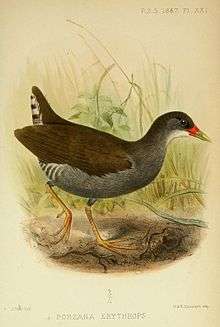Paint-billed crake
The paint-billed crake (Neocrex erythrops) is a species of bird in the family Rallidae.
| Paint-billed crake | |
|---|---|
 | |
| Scientific classification | |
| Kingdom: | Animalia |
| Phylum: | Chordata |
| Class: | Aves |
| Order: | Gruiformes |
| Family: | Rallidae |
| Genus: | Neocrex |
| Species: | N. erythrops |
| Binomial name | |
| Neocrex erythrops (Sclater, 1867) | |
| Synonyms | |
|
Mustelirallus erythrops | |
Taxonomy and etymology
This bird derives its name from its bright red beak.[2]
Description
This crake is small, measuring 18 to 20 centimetres (7.1 to 7.9 in) on average.[2] One was captured having a wingspan of around 200mm, a tarsus of 28mm and weighing in at 43 grams[3]
Distribution
The paint-billed crake is found in Argentina, Bolivia, Brazil, Colombia, Costa Rica, Ecuador, French Guiana, Guyana, Panama, Paraguay, Peru, Suriname, Trinidad and Tobago, and Venezuela. There is one record of the bird in the United States. Its natural habitats are subtropical or tropical seasonally wet or flooded lowland grassland, swamps, and pastureland.
Behaviour
This bird is nocturnal, active primarily during the night.[2]
This bird does not respond to playback[4]
Breeding
This bird builds its nest on the ground, under the protection of vegetation in grassy fields.[2]
The paint-billed crake is a territorial bird.[2]
This crake lays a clutch of three to seven eggs that are coloured creamy buff and have large, reddish blotches near the blunt end of the egg. This egg is incubated for a period of 24 days, with the parent sitting on the nest, thus camouflaging the nest.[2]
References
- BirdLife International (2012). "Neocrex erythrops". IUCN Red List of Threatened Species. 2012. Retrieved 26 November 2013.CS1 maint: ref=harv (link)
- Hauber, Mark E. (1 August 2014). The Book of Eggs: A Life-Size Guide to the Eggs of Six Hundred of the World's Bird Species. Chicago: University of Chicago Press. p. 59. ISBN 978-0-226-05781-1.
- Osborn, David; Beissinger, Steven R. (1979). "Paint-Billed Crake in Guyana". The Auk. 96 (2): 425. doi:10.1093/auk/96.2.425 (inactive 2020-03-25). Retrieved 2019-10-22.
- Dvorak, Michael (June 2017). "Conservation Status of Landbirds on Floreana: the Smallest Inhabited Galapagos Island". Journal of Field Ornithology. 88: 132–145. doi:10.1111/jofo.12197.
External links
- Associação Mãe-da-lua Paint-billed crake (Mustelirallus erythrops) - Photos and notes
